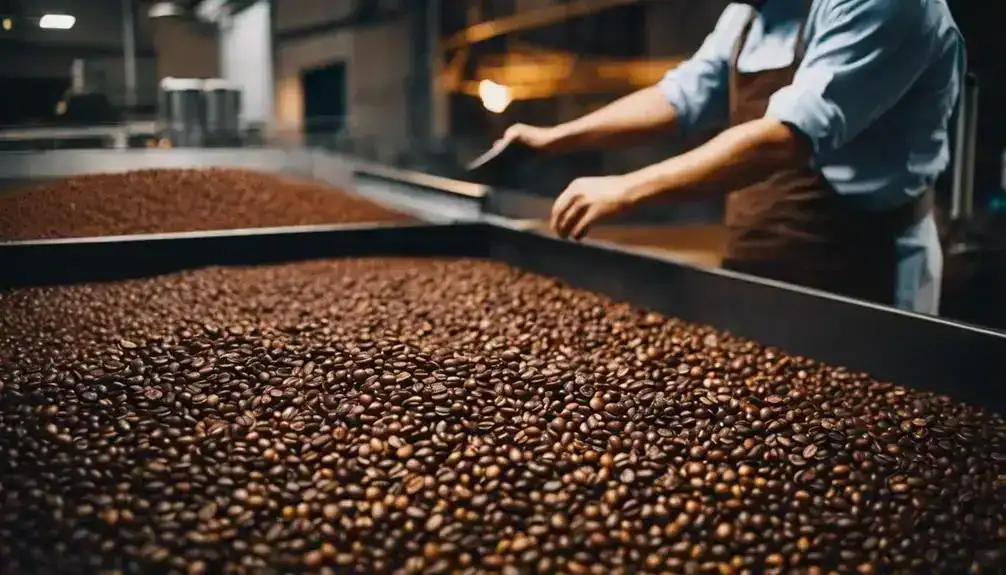When it comes to Arabica coffee processing, the method you choose can greatly influence the flavor profile of your brew. Have you ever wondered how different processing techniques impact the taste and aroma of your morning cup?
Understanding the intricate steps involved in transforming coffee cherries into a fragrant, flavorful beverage is key to elevating your coffee experience. Explore the nuances of Arabica coffee processing and discover how each stage contributes to the final product awaiting your enjoyment.
Arabica Coffee Processing Basics
You’re about to uncover the essence of Arabica coffee and its global significance.
You’ll learn the distinctive qualities that set Arabica apart from Robusta beans.
Let’s explore why Arabica is revered for its unique characteristics in the world of coffee processing.
The Essence of Arabica: Unveiling Its Global Significance
Unveiling the global significance of Arabica coffee reveals a rich history and a profound impact on the world’s coffee culture. Arabica’s cultivation, harvesting, processing, and flavor play a crucial role in shaping the coffee industry.
- Cultivation: Arabica is grown in diverse regions worldwide, each imparting unique flavors to the beans.
- Harvesting: The meticulous hand-picking of Arabica cherries ensures only the ripest ones are selected, contributing to its superior quality.
- Processing: Arabica beans undergo a rigorous process of washing, drying, and roasting, enhancing their complex flavors and aromas.
Understanding Arabica’s global significance offers a glimpse into the intricate world of coffee production, where innovation and tradition intersect to create a beloved beverage enjoyed worldwide.
The Distinctiveness of Arabica vs. Robusta
Arabica and Robusta coffee beans differ significantly in their flavor profiles and processing methods, setting the stage for exploring the fundamental distinctions between these two popular coffee varieties.
Arabica, known for its delicate flavors and acidity, is often favored for its nuanced taste profiles, while Robusta is recognized for its strong, bold flavor and higher caffeine content.
Here’s a quick comparison table showcasing the distinctiveness of Arabica and Robusta:
| Category | Arabica | Robusta |
|---|---|---|
| Flavor | Delicate, nuanced flavors | Strong, bold taste with earthy tones |
| Acidity | Higher acidity levels | Lower acidity but more bitterness |
| Caffeine | Lower caffeine content | Higher caffeine content |
| Cultivation | Grown at higher altitudes | Thrives at lower altitudes |
The Genesis of Arabica: From Seed to Harvest

You want to know the secrets behind cultivating the perfect Arabica beans and the techniques that make the harvesting process truly exceptional.
The ideal conditions for growing Arabica coffee will be unveiled, along with the precise methods that define the quality of the harvest.
Prepare to learn the intricate details that go into producing the finest Arabica coffee beans from seed to harvest.
Cultivation Secrets: The Ideal Conditions for Arabica
Exploring the optimal growing conditions for Arabica coffee plants is essential for ensuring a successful harvest from seed to fruition. When cultivating Arabica, consider these secrets for ideal conditions:
- Elevation: Aim for altitudes between 2,000 to 6,000 feet for the best results.
- Temperature: Maintain a consistent temperature range of 60-70°F to foster healthy growth.
- Shade: Provide partial shade to protect the plants from harsh sunlight and promote gradual ripening.
The Art of Harvesting: Techniques That Define Quality
When it comes to harvesting Arabica coffee, the techniques you choose can greatly impact the quality of the final product.
Hand picking ensures that each bean is carefully selected for ripeness, contributing to a superior brew. On the other hand, mechanical harvesting offers a blend of innovation and tradition, streamlining the process while still maintaining quality standards.
| Hand Picking | Mechanical Harvesting | Innovation Meets Tradition |
|---|---|---|
| Ensures Perfection | Efficient Collection | Maintains Quality Standards |
| Selective Process | Modern Approach | Blends Innovation with Tradition |
| Careful Selection | Streamlined Process | Ensures Consistent Quality |
Hand Picking: Ensuring Perfection in Every Bean
Hand picking ensures perfection in every Arabica coffee bean harvested by meticulously selecting only the ripest beans.
This manual process guarantees top-notch quality and flavor, as each bean is carefully chosen to meet the highest standards.
With handpicking, a personalized touch is applied to the selection process, ensuring consistency and excellence throughout the harvest.
- Selecting only the ripest beans
- Personalized touch in the selection process
- Consistent level of excellence
Mechanical Harvesting: Innovation Meets Tradition
Mechanical harvesting revolutionizes Arabica coffee production by integrating modern technology with traditional farming practices, ensuring efficiency and consistency in the harvesting process. Embrace innovation with these advancements:
- Precision machines optimize harvest time
- Automated sorting enhances quality control
- Integration of technology streamlines the production process
Experience the perfect blend of tradition and innovation in every cup of Arabica coffee.
The Heart of Flavor: Processing Arabica Coffee
When processing Arabica coffee, you’ll encounter three main methods:
- Wet processing for a clean taste,
- Dry processing for a more natural flavor, and
- Semi-washed processing for a unique honey-like sweetness.
Each method plays a crucial role in shaping the final flavor profile of your coffee beans. Understanding these processing techniques is key to unlocking the full potential of your Arabica coffee beans.
Wet Processing: Crafting the Washed Coffee
When it comes to crafting washed coffee, you need to understand the crucial steps involved. Get ready to explore the heart of flavor with these key points:
- Depulping: The First Step to Purity
- Fermentation: Unlocking the Flavors
- Washing: The Rinse of Clarity
Depulping: The First Step to Purity
At the heart of crafting the washed coffee lies the crucial step of depulping, which sets the foundation for purity and flavor in Arabica coffee processing.
- Mucilage Removal: Through depulping, the mucilage layer surrounding the coffee beans is effectively removed.
- Enhanced Washing: Washing the beans post-depulping ensures the removal of any remaining residues.
- Pre-Fermentation Prep: Depulping prepares the beans for the fermentation process, unlocking unique flavors.
Fermentation: Unlocking the Flavors
After depulping, the next crucial step in processing Arabica coffee is fermentation, which plays a key role in unlocking the unique flavors of the beans.
- Fermentation enhances the complexity of flavors.
- Hull and polish processes follow fermentation.
- Fermentation impacts the final grade of the coffee.
Washing: The Rinse of Clarity
During the washing stage of Arabica coffee processing, the beans undergo a crucial rinse that brings clarity to their flavors.
- Precision Techniques: Employing advanced methods for optimal results.
- Clarity Enhancement: Enhancing the flavor profile through meticulous washing.
- Innovative Rinse Approaches: Exploring new ways to elevate the clarity of the beans.
Drying: Preparing for the World
As the beans have undergone the crucial rinse during the washing stage, the next step in processing Arabica coffee involves preparing them for the world through the drying process.
- Embrace the sun-dried method for a natural touch.
- Consider mechanical drying techniques for efficiency.
- Opt for eco-friendly practices to enhance sustainability.
Dry Processing: Embracing the Natural Process
When it comes to dry processing Arabica coffee, you’re in for a treat. This natural method brings out the unique flavors and complexities of the beans. Get ready to experience the essence of Arabica coffee through:
- Drying Cherries: Simplicity Meets Complexity
- Hulling: Revealing the Bean
- Unique Flavor Profiles: A Result of Natural Processing
Drying Cherries: Simplicity Meets Complexity
Have you ever pondered how the drying process transforms coffee cherries into the complex flavors we savor in each cup of Arabica coffee? Drying cherries is where simplicity meets complexity in coffee processing.
The process involves carefully managing moisture levels to enhance the beans’ flavors and characteristics. This critical step sets the foundation for the unique taste profiles found in Arabica coffee.
- Moisture management is key
- Flavor development through controlled drying
- Complexity arises from the simplicity of the process
Hulling: Revealing the Bean
Hulling the coffee cherries is a crucial step that unveils the prized bean within, unlocking the essence of flavor for Arabica coffee enthusiasts worldwide.
- Milling: Precision grinding to reveal the bean.
- Sorting: Innovative techniques to ensure quality.
- Polishing: Enhancing the bean’s appearance and flavor.
Semi-Washed Processing: The Honey Process
When processing Arabica coffee using the Honey Process, it’s crucial to maintain a precise balance between depulping and drying. To kickstart your understanding of this method, consider the following key points:
- Harnessing the sweetness of the mucilage
- Controlling fermentation for flavor development
- Monitoring drying times for optimal results
Depulping and Drying: A Delicate Balance
Finding the delicate balance between depulping and drying is essential for unlocking the full flavor potential of Arabica coffee during the semi-washed processing, especially in the Honey Process.
- Enhanced Aroma: Controlled depulping and drying methods intensify the coffee’s aroma.
- Consistent Flavor: Proper fermentation during depulping contributes to a consistent flavor profile.
- Complexity in Taste: Balancing drying times adds layers of complexity to the coffee’s taste.
The Final Touches: Drying and Milling Arabica Coffee

As you reach the final stages of processing Arabica coffee, you’ll encounter the crucial steps of drying and milling.
The way the coffee beans are dried, whether through traditional sun-drying methods or modern technological advancements, greatly impacts the final flavor profile.
Following the drying stage, the meticulous processes of hulling and polishing are undertaken to ensure the beans are of the highest quality before they reach your cup.
Drying Methods: From Sun to Technology
When drying Arabica coffee, you have two main methods to consider: sun drying and mechanical drying. Sun drying allows for a natural process, while mechanical drying offers speed and consistency. Each method has its own advantages and considerations to keep in mind.
| Drying Method | Description | Considerations |
|---|---|---|
| Sun Drying | Uses natural sunlight to dry the coffee beans. | Slower process, weather-dependent. |
| Mechanical Drying | Utilizes machines to speed up the drying process. | Requires energy source, ensures consistency. |
Sun Drying: Nature’s Own Method
For the final stage in processing Arabica coffee, sun drying emerges as nature’s own method, lending a unique touch to the beans’ journey towards perfection.
- Sun drying naturally reduces moisture levels.
- Exposure to sunlight enhances flavor development.
- Farmers have limited control over the drying process.
Mechanical Drying: Speed and Consistency
Moving from the traditional sun drying method, farmers often turn to mechanical drying for Arabica coffee processing, seeking speed and consistency in the final stages of production. When it comes to mechanical dryers, innovation is key.
You’ll find that these modern machines offer:
- Rapid drying capabilities
- Enhanced uniformity in moisture levels
- Greater control over the drying process
Hulling and Polishing: The Pursuit of Perfection
When it comes to perfecting your Arabica coffee, the hulling process and polishing stage are crucial. These steps bring out the best in your beans, ensuring a premium product.
- Hulling: The Outer Shell Removal
- Polishing: The Final Gloss
- Attention to Detail: Ensuring Perfection
Hulling: The Outer Shell Removal
To achieve the perfect Arabica coffee beans, hulling, the process of removing the outer shell, is a crucial step in the pursuit of excellence. When hulling, consider these innovative techniques:
- Utilize advanced machinery for precise cherry processing
- Opt for eco-friendly methods to reduce environmental impact
- Implement solar drying to enhance flavor profiles
Polishing: The Final Gloss
After hulling the outer shell to perfection, the next step in the pursuit of excellence is polishing, where the final gloss is applied to the Arabica coffee beans. This crucial processing stage ensures a pristine finish and enhances the overall quality of the beans.
Innovations in polishing techniques have led to increased efficiency and consistency in achieving the desired final gloss.
- Cutting-edge technology for precise polishing
- Specialized equipment for uniform gloss application
- Quality control measures for perfect finishing
Excellence in Every Bean: Sorting and Grading

You must understand the importance of size and density when it comes to sorting and grading Arabica coffee beans.
By following strict criteria for classification, you ensure that only the highest quality beans make the cut.
Additionally, adopting a zero-tolerance approach towards defect removal is crucial in maintaining the excellence of every bean.
Size and Density: The Criteria for Classification
When assessing Arabica coffee beans, the size and density serve as crucial criteria for classification, ensuring excellence in every batch through meticulous sorting and grading.
By categorizing beans based on their size and density, coffee producers can maintain consistency and quality in their final product. Larger beans often exhibit a more complex flavor profile, while denser beans tend to have a richer taste.
This classification system allows for a more precise approach to blending and roasting, resulting in a superior cup of coffee.
| Size | Density | Classification | Criteria |
|---|---|---|---|
| Large | High | Specialty | Select |
| Small | Medium | Commercial | Standard |
| Medium | Low | Defective | Reject |
The Zero-Tolerance Approach: Defect Removal
Maintaining the meticulous standards set by size and density classifications, the zero-tolerance approach in defect removal ensures that every Arabica coffee bean meets the highest quality standards in the sorting and grading process.
When it comes to defect removal, innovation is key. Here’s how you can achieve excellence in every bean:
- Advanced Sorting Technologies: Utilize cutting-edge machinery to identify and separate defective beans efficiently.
- Stringent Grading Protocols: Implement strict protocols to guarantee only the finest beans make the cut.
- Specialized Techniques for Pulped and Washed Beans: Tailor defect removal methods to the specific processing methods of pulped and washed Arabica coffee beans.
Unlocking the Aroma: Roasting Arabica Coffee

When roasting Arabica coffee, you initiate a captivating process that transforms raw beans into aromatic wonders.
The heat applied during roasting is the catalyst for this magical metamorphosis, bringing out the rich flavors and enticing aromas hidden within.
Get ready to witness and experience the alchemy of roasting as you embark on this flavorful journey.
The Transformation Through Heat
When it comes to roasting Arabica coffee, the heat plays a crucial role in unlocking the aroma and flavor of the beans.
To understand this process better, consider the following key points:
- Light Roast: Delicate and Complex
- Medium Roast: The Balance of Flavor
- Dark Roast: Bold and Intense
Light Roast: Delicate and Complex
Unlocking the delicate and complex flavors of Arabica coffee occurs through the meticulous application of heat during the light roast process.
- Light roasting preserves the bean’s natural aroma.
- The light roast brings out the nuanced taste profiles.
- This roast level retains the coffee’s inherent sweetness and acidity.
Medium Roast: The Balance of Flavor
Moving from the delicate and complex flavors of light roast, the medium roast brings a balanced blend of flavors to the forefront of Arabica coffee processing. When roasting Arabica beans to a medium level, you achieve a perfect balance of acidity, body, and aroma. This roasting style enhances the coffee’s natural attributes, creating a harmonious flavor profile that’s both versatile and satisfying.
- Achieves a perfect balance of acidity
- Enhances the coffee’s natural attributes
- Creates a harmonious flavor profile
Dark Roast: Bold and Intense
To bring out the bold and intense flavors of Arabica coffee, dark roast is a crucial step in the processing journey. Dark roasting Arabica beans creates a rich, smoky flavor profile that appeals to those who crave a robust coffee experience.
The intense heat during roasting caramelizes sugars in the beans, resulting in a deep, complex taste that lingers on your palate.
Embrace the darkness for a truly bold coffee adventure!
- Rich, smoky flavor profile
- Robust coffee experience
- Deep, complex taste
From the Roaster to the Cup: Packaging and Distribution

When it comes to packaging Arabica coffee, sealing in freshness is key to preserving its rich flavors.
As you consider the distribution channels for your coffee, think about the global pathways that can help your product reach coffee lovers worldwide.
Understanding the art of packaging and the intricacies of distribution will ensure that your Arabica coffee makes its way from the roaster to the cup with excellence.
Sealing Freshness: The Art of Packaging
Ensuring optimum freshness and flavor retention, the packaging process for Arabica coffee demands meticulous attention to detail and quality control. When sealing the goodness of Arabica coffee, consider these innovative techniques:
- Modified Atmosphere Packaging (MAP): Utilizing specific gas mixtures to extend shelf life.
- One-Way Degassing Valves: Allowing the release of CO2 without letting oxygen in, preserving freshness.
- Vacuum Sealing: Removing air to prevent oxidation and maintain the coffee’s quality.
Global Pathways: Distribution Channels Unveiled
Sealing the freshness through meticulous packaging techniques sets the stage for the journey of Arabica coffee along its global pathways of distribution.
When it comes to distributing Arabica coffee globally, the focus is on sustainable practices and fair trade. Certified distributors ensure that the beans reach consumers with quality and ethical standards intact.
By choosing global distribution channels that prioritize sustainability and fair trade practices, you are not only enjoying a premium product but also supporting a system that benefits farmers and the environment.
Take a look at the table below to see how these key factors play a role in the distribution of Arabica coffee:
| Distribution Channel | Key Feature |
|---|---|
| Sustainable | Eco-friendly |
| Fairtrade | Ethical sourcing |
| Certified | Quality assurance |
| Global | Wide reach |
Beyond the Bean: Environmental and Social Considerations

When processing Arabica coffee beans, it’s crucial to consider the environmental and social impact of your practices.
Embracing green processing methods and sustainable approaches can help minimize harm to the ecosystem and support the well-being of coffee-producing communities.
Green Processing: Sustainable Practices in Arabica Production
When considering sustainable practices in Arabica production, you should focus on:
- Conserving water through innovative wet processing methods
- Seeking out organic and fair trade certifications for a more ethical bean
- Supporting environmentally and socially responsible practices in the coffee industry
Conserving Water: Innovations in Wet Processing
To enhance sustainability in Arabica coffee production, implementing innovative water conservation techniques during wet processing is crucial.
- Recycling Water: Reusing water in different stages of processing.
- Water-Efficient Equipment: Installing machinery that minimizes water usage.
- Eco-Friendly Disposal Methods: Properly treating and disposing of wastewater to prevent contamination.
The Ethical Bean: Organic and Fair Trade Certifications
Exploring the realm of ethical certifications, such as Organic and Fair Trade, adds a layer of transparency and accountability to the Arabica coffee supply chain.
- Organic Certification: Ensures the coffee is grown without synthetic chemicals.
- Fair Trade Certification: Guarantees fair prices and working conditions for farmers.
- Ethical Sourcing: Promotes sustainable practices and supports community development.
The Future Brews: Innovations in Arabica Coffee Processing

You can explore the exciting advancements in Arabica coffee processing that are shaping the future of this beloved beverage.
Discover how technological breakthroughs aren’t only enhancing quality but also promoting sustainability in the industry.
Join the quest for perfection as innovation continues to elevate the overall quality of Arabica coffee.
Technological Breakthroughs: Enhancing Quality and Sustainability
Embracing cutting-edge technologies has revolutionized the way Arabica coffee is processed, elevating both its quality and sustainability standards. Innovations in the coffee industry are continuously pushing boundaries to enhance every aspect of the coffee journey.
Here are some key advancements shaping the future of Arabica coffee processing:
- Precision Roasting Techniques: Utilizing tech-driven roasting processes to unlock the full potential of each bean.
- Smart Water Management Systems: Implementing sustainable practices to reduce water waste and preserve the environment.
- Blockchain Traceability: Leveraging technology to provide consumers with transparent information about the coffee’s journey from farm to cup.
These innovations not only improve the quality of Arabica coffee but also contribute to a more sustainable and transparent coffee industry.
The Quest for Perfection: Improving Quality Through Innovation
As advancements in technology continue to reshape the Arabica coffee processing landscape, the pursuit of perfection in quality through innovation is driving the future of the industry.
Coffee enthusiasts are constantly seeking ways to enhance the cupping experience, improve assessment techniques, and elevate the overall evaluation of Arabica beans to new heights.
Here are some exciting innovations that are shaping the future of Arabica coffee processing:
- Introduction of AI-powered cupping tools for more precise flavor profiles
- Utilization of blockchain technology for transparent bean quality assessment
- Integration of IoT devices for real-time monitoring and improvement of processing techniques
With these advancements, the industry is poised to revolutionize the way Arabica coffee is processed and enjoyed, ensuring a superior coffee experience for consumers who value innovation and quality.
Conclusion
As you sip your perfectly brewed cup of Arabica coffee, remember that each bean has undergone a meticulous journey from seed to harvest, processing to roasting. Like a symphony of flavors dancing on your taste buds, each sip tells a story of dedication and craftsmanship.
So savor every moment, as you indulge in the rich aroma and velvety smoothness that only Arabica coffee can offer. Let each sip be a celebration of the artistry that went into creating your perfect cup.

